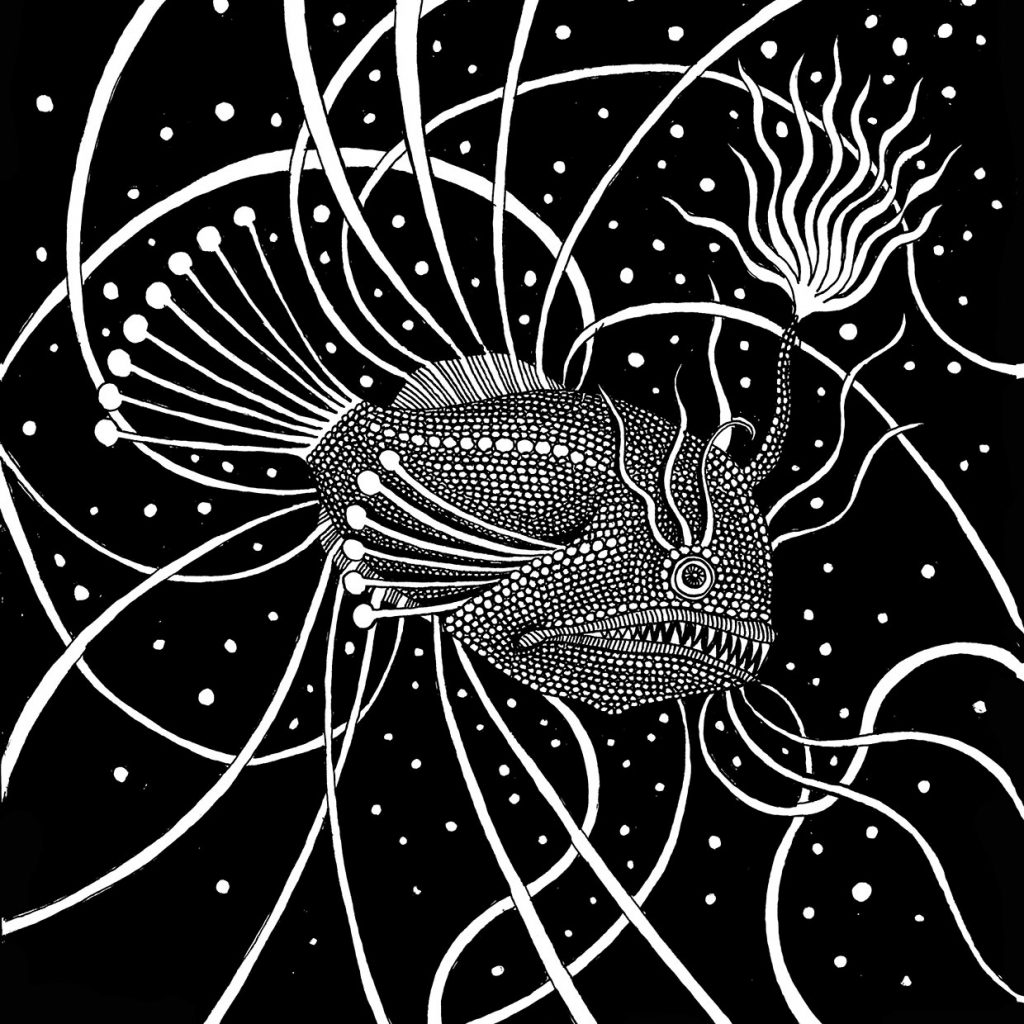To see which of the drawings are available and to purchase them please visit my shop.
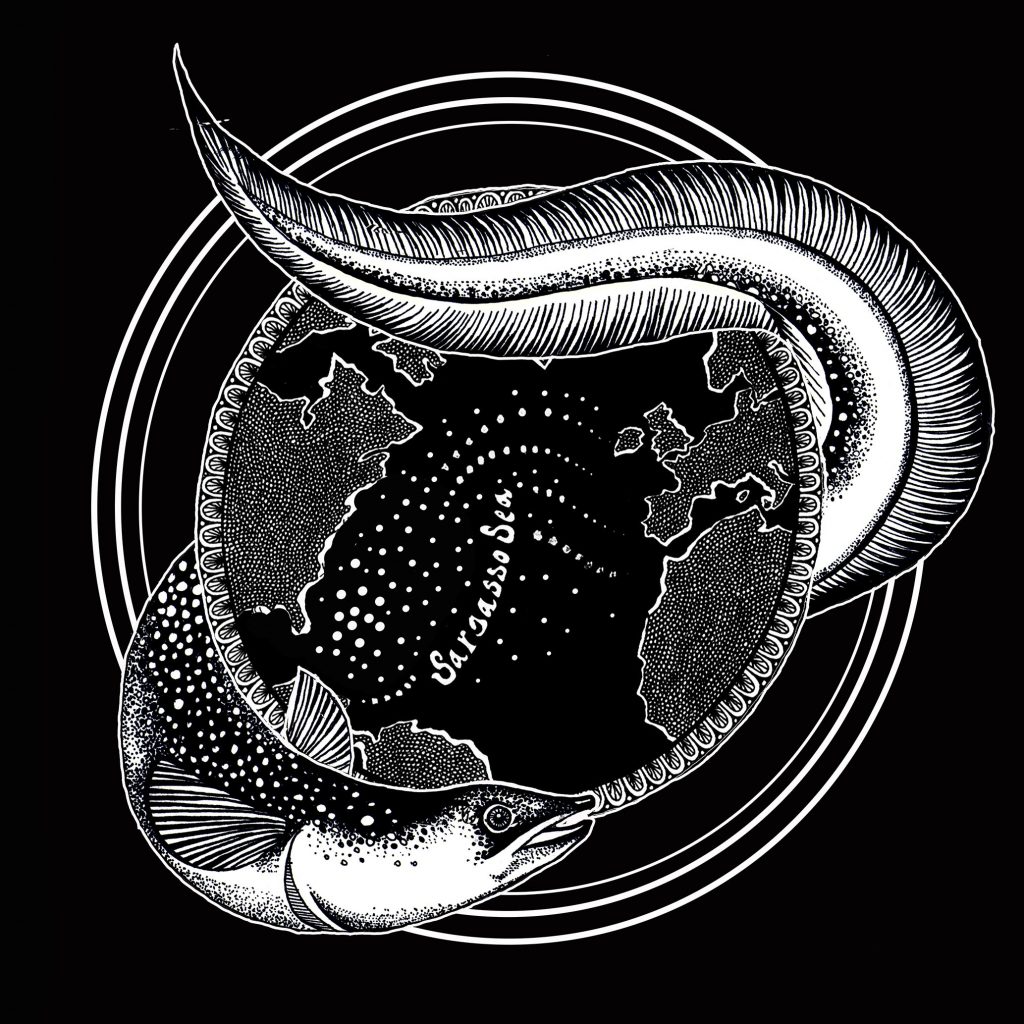
The European eel: Anguilla anguilla
Until the early 20th century there was no consensus on the origin of “elvers’ as small eels are called, and to put a long story short, it took a transatlantic research journey by a dane of the name Johannes Schmidt to confirm the catadromous nature of eels. The truth of the matter is, that as eels become sexually mature, they flush themselves out of the European rivers and swamps, migrate to the Sargasso sea (just off Bermuda) where they descent into the depths of the oceans, reproduce and die. What emerges are small asexual ‘pin-head’ eels that look like transparent leaves. These somehow manage to transport themselves back to Europe where they migrate up streams and rivers to take up their freshwater lifestyle. This is not the end of it- eel sexuality is the next enigma. At some point or another eels become either male or female, but the sequence, synonymity, and reason for their sexuality has not been fully understood. The man, Sigmund Freud himself, spent his earlier years trying to decipher the secrets of the male parts of eels- after which he gave up and dedicated himself to the more straightforward task of psychoanalysis and illumination of the subconscious.

Ocean Manta Ray, Mobula birostris
The giant oceanic manta ray is, as the name suggests, the largest species of ray in the world. Rays, like sharks, belong to a class of fish called the Chondrichthyes. They are distinguished from other fish by the fact that their skeleton is not made out of bone, but rather cartilage. Giant manta rays can reach sizes up to 7 metres across the ‘wings’, all on a strict diet of zooplankton which they filter out of the water. Remarkably, they also have the largest brain-to-body ratio of all cold-blooded fish.
This particular manta, Mobular birostris, is found all around the world from the coastal shelves to the open ocean. Although previously thought that they lived a life of migrating across oceans, like other large pelagic fish, recent studies have shown that they tend to prefer shorter travels and staying close to home. They mature slowly and breed only every 5 or so years, making them very vulnerable to disturbances.
When they aggregate in large groups, as they are often observed to do around breeding time or specific food sites, the collective noun for them is a squadron of rays.

The lancet fish, Alepisaurus ferox
The lancet fish is a glorious monstrosity found in the twilight zone of ocean. Their name “Alepisauurus” means scaleless-lizard and as it suggests, these fish don’t have scales but rather a slimy kind of skin covered in pores. Their muscles are very gelatinous, which has led scientists to think that despite their aggressive looking appearance, they are probably not very fast swimmers, and thus probably catch their prey using ambush techniques. In addition to a wide variety of mid pelagic creatures they are known to be voracious cannibals, the reason for one of their common names “the cannibal fish”.
They are mysterious and not much is known about their life cycle, but from the specimen studied we assume that lancet fish are simultaneous hermaphrodites, possessing both male and female functional sexual organs.
An absolutely stunning fish, I encourage everyone who hasn’t checked them out yet, to google lancetfish and see their dragon-like magnificence first hand!
Mola mola is the largest bony fish in the world, and probably one of the weirdest as well. It’s huge size and strange dimensions of up to 3.3m length and 4.2m across the fins makes it a very improbable swimmer and it spends most of its time floating around with little direction or purpose. The skeleton is particularly interesting, as it has managed, through some joke of evolution, to get rid of its caudal fun and instead bend its body in a half circle to make up for the missing rudder.
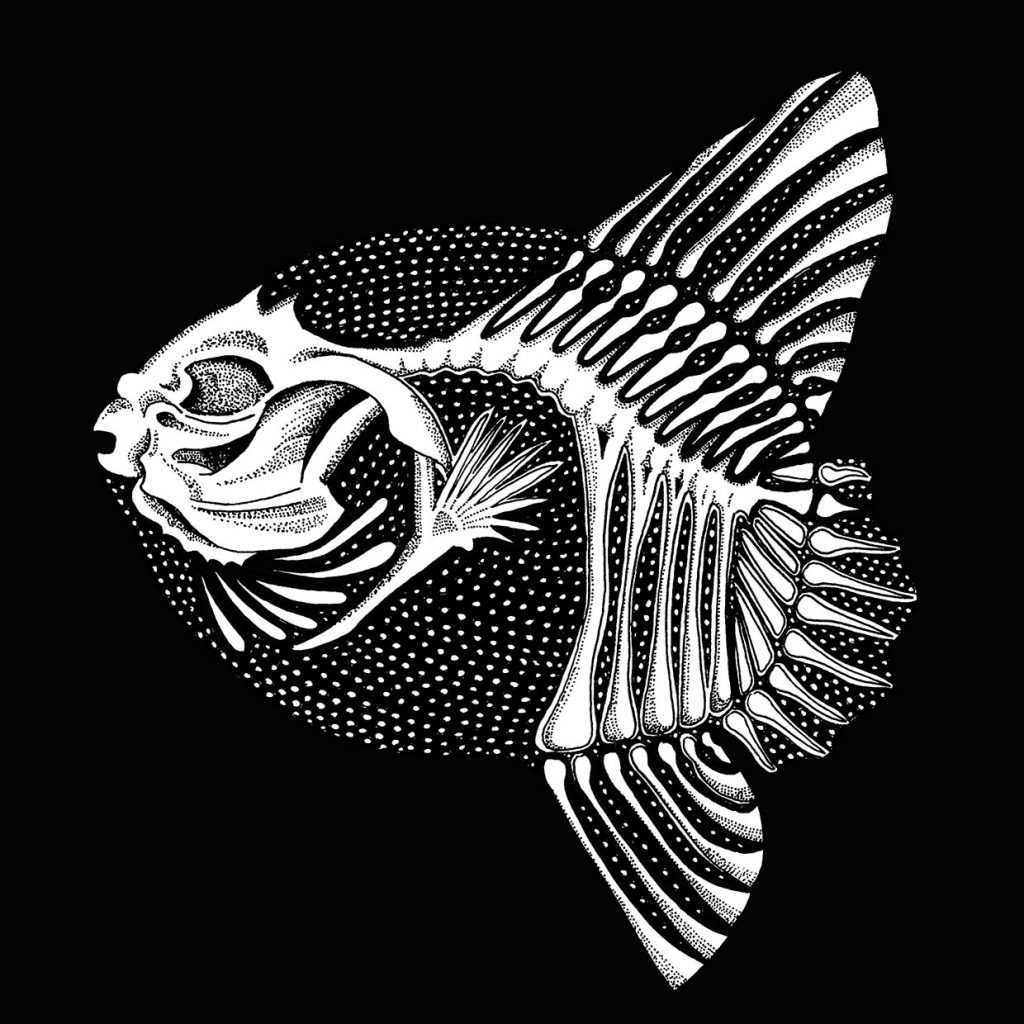

Peruvian anchovy: Engraulis ringens
“The world’s most exploitated fish”. After supporting the world’s largest single stock fishery for decades, Engraulis ringens became infamous when the fishery crashed in 1972, due to overfishing as well as strong environmental disturbance caused by an El Nino event.
Although the stock recovered to some extent and continued to supply the world with food and more importantly fish meal for agri- and aquaculture, the initial collapse was a moment of reckoning for fisheries worldwide. The sea’s resources are not infinite after all.
The white spotted pufferfish
The nests of the white spotted pufferfish Torquigener albomaculosus pussled divers for years. Like alien crop circles no one could figure out who made these elaborate patterns in the sand. As it turns out, the males of this species use their fins to fan sand into immaculate geometric patterns as a means to attract females. Once a female has been lured in by his artistic talents she will spawn her eggs in the middle of the pattern, gather her things and leave. It is then up to the father to fertilize the eggs and protect them from all harm. The patterns that he has constructed in the sand will funnel fresh water towards the eggs to keep them oxygenated during their development.


The Coelacanth: Latimeria chalumnae
“ I could not have been more surprised had I seen a dinosaur walk down the street”
When the first living coelacanth was found in East London in it blew up the world of fish. Thought to have gone extinct at the same time the dinosaurs disappeared, scientists couldn’t believe their eyes when one was found by a fishing vessel off the coast of South Africa. Known only through the fossil record, from ages far gone, this spectacular fish proved that a lack of recent traces does not mean that an animal has disappeared from the planet. Since then many more have been found, and even another species- Latimeria menadoensis has been found around Indonesia.
The coelacanth belongs to the lobe-finned fish, the Sarcopterygii
-the fins are supported by bone and have fleshy appendages. This is the lineage that we belong to as well, meaning that we, humans, are closer related to the coelacanth than the coelacanth is related to any of the ray finned fish.
The leafy Seadragon: Phycodurus eques.
The leafy seadragon belongs to the family of the sygnathidae, together with the sea horses and pipefishes. The genus Phycodurus only has one other species, the equally spectacular weedy seadragon.
Like seahorses, the body of seadragons is covered in bony plates, giving them their iconic and quite unfishy look. Seadragons have further developed appendages around their body that serve to camouflage them in their seaweed habitat.
As with seahorses, it is the male that broods the eggs, however, Seadragons do not have a pouch like the seahorses, but instead a “brooding patch” on the underside of the males tail. After elaborate courtship rituals, including dances and mirroring between the partners, the female will deposit her bright pink eggs on his brooding patch, where cups hold each egg individually and ensure flow of oxygen rich blood. Brooding will last 6-8 weeks after which the miniature seadragons emerge fully formed and ready to take on the world.
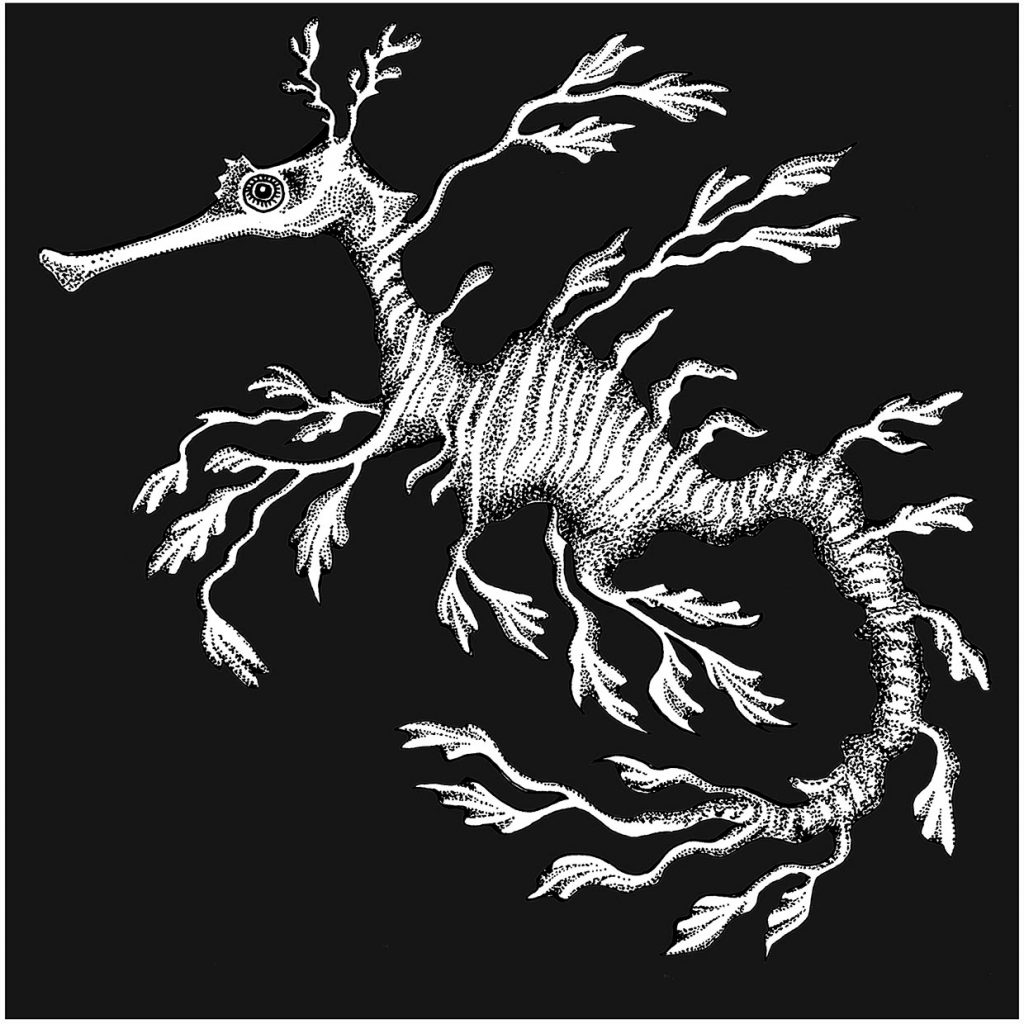
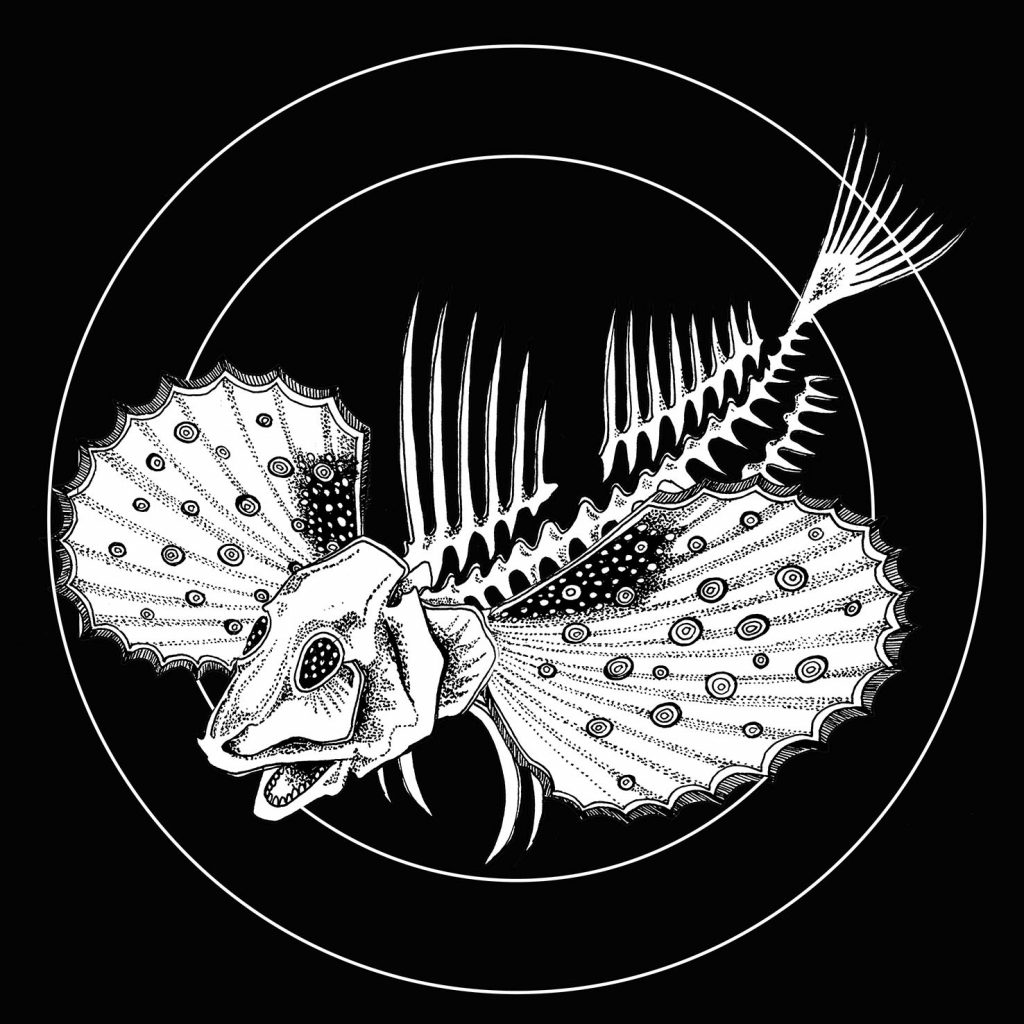
The blue fin Gurnard: Chelidonichthys kumu
This little fish is common around new Zealand, where it is known as “Kumu-kumu” by the maoris. Despite the impressionthat its beautiful wing-like pectoral fins give, it is very much a bottom dwelling fish, with strange finger like appendages in the stead of its pelvic fins, which the fish uses to ‘walk’ around the seabed and rummage around for food.
The ‘wings’ are most probably a defense mechanism, as seen in other fish. When Kumu-kumu feels threatened he will lift them up so that the black dots in the middle look like huge eyes glaring at whoever ventured to close to them, and give the impression of a much larger animal.
Apparently they grunt or croak like a frog when caught, thus the name “gurnard” which means ‘to croak’ in French.
The Senegal Bichir: Polypterus senegalus
Bichirs belong to the Polypteridae family- an old family, so old that they are considered the first family to branch off from all the other ray finned fish. Their jaw structure for example is thought to resemble that of tetrapods more closely than that of other ray finned fish.
They live in freshwater and swamp habitats and have retained a special feature- they have primitive paired lungs in addition to their gills and can alternate between breathing air and water. This comes in handy when the shallow water bodies they inhabit become stagnant and oxygen becomes poor. While they can use their mouth for inhalation they also have two very cute ‘spiracles’ on the top of their snout for this purpose. Some species have further been observed using their pectoral fins to waddle between pools of water when conditions get too dry and difficult.


The giant oarfish: Regalecus glesne
The maginificent giant oarfish is the longest bony fish known to us, measuring up to 11 metres in length. He belongs to the royal family of fish “Regalecidae” and is distinguished by the beautiful crest on his head, made up of some very elongated dorsal spines, with the occasional flap of skin at the end. It is thought that its fantastic appearance might have led to one or the other sighting of seamonsters across the centuries.
The ominous association is further extended by the legend of the oarfish as the “messenger of the sea god’s place” in japan. Sightings of stranded oarfish have been associated with the coming of natural disasters for a long time, and according to lore, the stranding of a high number of specimen of Regalecus russelli (a sister species of the giant oarfish) in 2009 and 2010 was thought to foreshadow the 2011 Fukushima tsunami.
Atlantic Bluefin Tuna: Thunnus maccoyii
Since the 1940’s and 1950’s the demand for the ‘red meat’ of these fish, so much richer than that of other fish, has risen enormously. In the early stages of the fishery, tuna we predominantly canned for export to Europe or north America as pet food or a cheap protein source for humans in the aftermath of the second-word war . This however changed, when tuna became integrated into the Japanese cuisine as sashimi, and larger and larger quantities were required for both the japanese consumers, as well as westerners who grew more and more enthusiastic about sushi.
Since the tuna was showing signs of overexploitation (it has since been listed by CITES as critically endangered), quotas were imposed on all nations fishing the southern bluefin. Despite these efforts the stocks have not noticeably recovered, and there have been repeated reports of nations admitting to taking much more than they have been allocated. Due to the heightened restrictions around the fishing of this species, their worth has risen enormously. A 278-kilogram bluefin tuna sold for 333.6 million yen ($3.1 million) at a Tokyo market in 2019, making it the most expensive fish in our history. As a grotesque consequence of this, there is a big industry of freezing tuna- once we have fished the last one from the sea, as is foreseeable, some clever capitalist will be able to get rich on the back of the decimation of a species.


Bristlemouths: Cyclothone
Bristlemouths from the genus Cyclothone are thought to be the most abundant vertebrates on earth, estimated to number in the quadrillions. How come I ve never seen one then you might ask. Well, since they live in the mesopelagic, the twilight zone of the ocean, are not very large or impressive, scientists themselves only caught on to the abundance of these fish in the 1930’s when the famous scientist William Bebe observed vast numbers of them, chasing copepods, from his spherical submersible, half a mile down.
A number of trawls across the different oceans at a wide range of depths have since then confirmed the little fish’s claim to the title of highest abundance.
Like many other fish it is protandrous- meaning that it starts its life as a male and will only become a female at a larger size. They have tiny fangs for catching the small crustaceans that roam the oceans, and are equipped with small light emitting “photophores” which serve to illuminate their bellies, so that a predator looking up from below cant see their silhouette against the lighter water.
Zebra shark: Stegostoma Fasciatum
This is a very holy fish for a holy Sunday! In 2016 a zebrashark lady gave virgin birth to little jesus sharks (although they were all girls). Parthenogenesis, as this process is called scientifically, has been observed in a number of shark species (including the bonnethead and the blacktip shark), but the zebrashark is particularly close to my heart, as I had the pleasure of meeting Leonie and her pups in 2016 at the HQ Aquarium in Townsville where I was studying at the time. The ability to fertilise their own eggs has been most commonly observed in Aquariums where sharks in solitary confinement might resort to this measure, but recent DNA sampling of wild populations has confirmed that this trick is not only reserved for captivity, but can come in handy in a variety of circumstances.

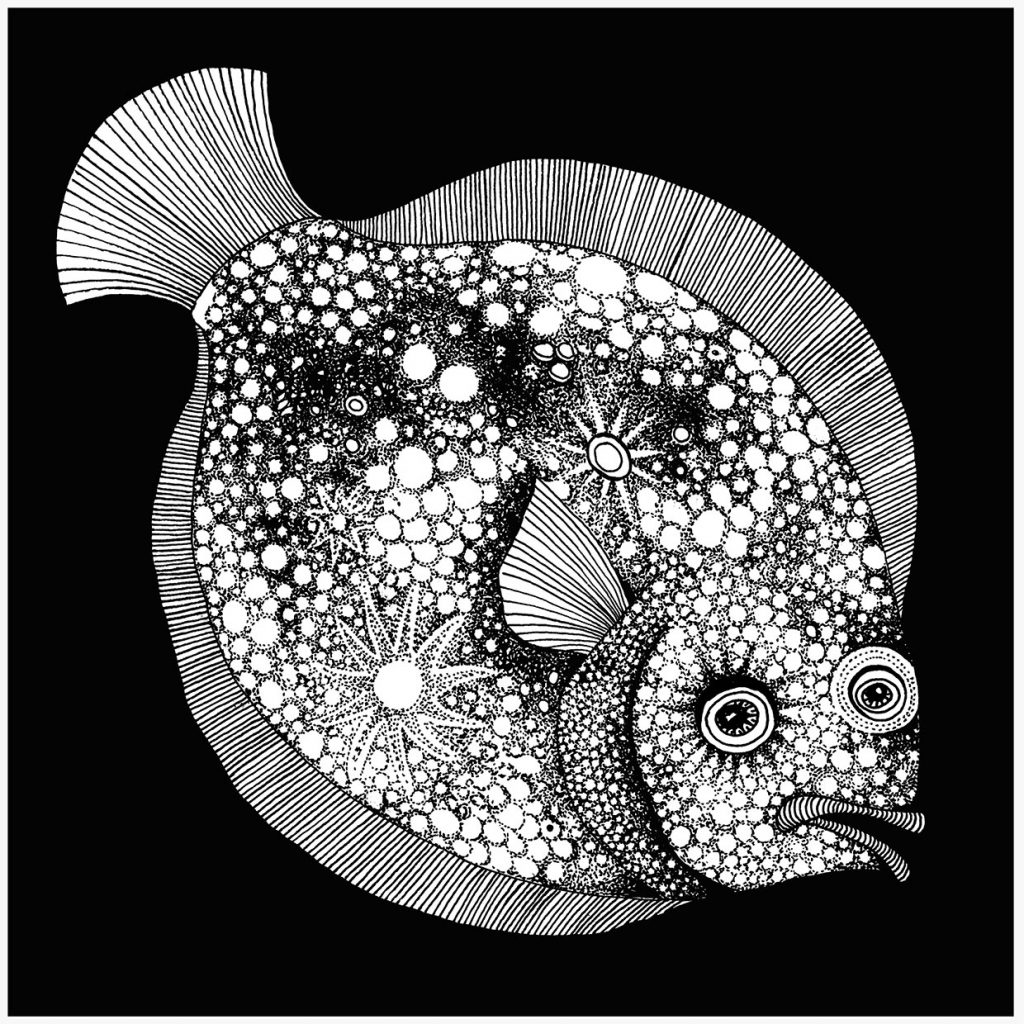
The Brill: Scophthalmus rhombus
Part of the same order of fish as the flounder or the sole. All of these are referred to as flat fishes and are perfectly adapted for life on the ground, in habitats ranging from freshwater lakes, to the brackish water of estuaries or deep sea marine seafloors. All of the Pleuronectidae start of as ordinary little fish, with roundish bodies and eyes on different sides, as is proper. However at one stage of their development, as they are changing from a free life in the water column to their ancestral sea-bottom reign, one of their eyes begins to slowly creep across their face, until it finds its place close to the other one. Which of the eyes (right or left) moves depends on the species. Now, with the eye in place, the fish can happily look up at the water , scanning it for predators or other hazards. The fact that the upper side of their pancake-body has the ability to change its colour and pattern according to the surface they are on obviously helps much with the quiet and undiscernible existence.
Parrotfish: Family scaridae
Parrotfish with their stunning, almost-too-bright-to-be-real colours are a popular feature for snorkellers and divers on coral reefs around the world. Most of them are a combination of herbi and coralivores, meaning that they feed on the algae and reef. For crunching the limestone they have characteristic powerful teeth, which, in their semblance to a beakhave given them their feathery name association.
Parrotfishes are not only complicated and diverse in their patterns, but even more so in their intricate social and sexual structures. Many of their species are diandric, which means that there are primary males, as well as secondary males (which were born female but eventually changed sex). The physical and visual changes that the fishes undergo at stages of maturation or sex changes are so startling, that for many years scientists took fish from different developmental stages to be different species. Mating structures are diverse, with many species being structured into male dominated harems, while other species form monogamous pairs and others still fertilise and spawn in carnivalesque orgies.
Parrotfish are extremely important to reef health- more and more research is emerging that shows that the removal of parrot fish from reefs through fishing or other disturbances leads to poor reef health. With algae left uncontrolled, the reef structure gets overgrown, strangling the corals and leading to death by light deprivation and much higher susceptibility to bleaching.


Hagfish : class Myxini
This is one of the most ancient groups of fish, never having developed jaws, the closely resemble the fish’s clade ancestors from 300 million years ago. They are eel-shaped and are known and feared for two things: their unpleasant habit of consuming carcasses from the inside out, and their ability to produce obscene amounts of slime when threatened.
This last habit has led to mishaps where hagfish produced too much slime and suffocated as a result. Their solution to this problem shows their more innovative nature: when the slime gets out of hand they tie themselves into a neat knot that allows them to rid themselves of the slime hands-free!
Flying Fish- Family Exocoetidae
Flying fish are poetically wondrous masters of the elements. Their enlarged and delicately formed pectoral fins give them the possibility to glide through the air in an effort to escape predators such as tuna lurking beneath the waves. Their form is aerodynamic, and their bone structure has evolved to maintain a rigid and perfect posture in flight.
Once the fish has gained enough speed underwater (around 50 km/h) it pushes itself through the barrier from the supportive water mass to the frighteningly fickle medium of air, the wings expand to allow glides up to 200 metres. But this doesn’t have to be the end of it, as through a specific wiggling of its hypocercal tail on the surface of the ocean (the taxi stage) it can gain enough traction to take off again. Consecutive glides can thus amount to about 400 metre without the fish ever leaving the air.


The Whale shark: Rhincodon typus
Called: Marokintana meaning “many stars” in Magalasy by the Madagascan people. Whale sharks are gentle giants, basking in tropicals waters around the world. They are the biggest fish, reaching lengths up to almost 19 metres, with mouths that alone can span 1.5 metres. This huge mouth is not only good for grinning in a friendly fashion, but are also supreme tools for filtering large amounts of water for their diet of plankton, being only one of three shark species that are filter feeders.
Like other sharks, Whalesharks are ovoviviparous, meaning that they give burth to life yound that have hatched from their eggs inside of the mother. However, they show us another trick- while not completely uncommon, less recognized. That is the storage of sperm by different suitors, which the female keeps to fertilize her eggs, presumably at will, to keep a constant stream of babies emerging. This means that one female can carry a large number of eggs, all at different developmental stages and from a number of different fathers.
Sturgeon: Family Acipenseridae
Sturgeons are another group of ‘ancient’ fish, estimated to have remained more or less unchanged since the Triassic period, some 245- 208 million years ago. They certainly look prehistoric, with bony plates covering their body in 5 lateral rows and their very solid skull structure, and it is thought that this formidable armour in addition to their large size (some sturgeons can reach lengths of 5.5 metres) has reduced predator effects on their evolution.
These fishy dinosaurs are found in temperate climates, inhabiting estuaries, lagoon and riversystems in the Eurasian and north-american regions. Like Salmon they are anadromous, meaning that they require freshwater for spawning, while spending the majority of their adult life in brackish or marine environments. Here they forage for invertebrates and fish along the ground, using their sensitive barbels to detect movement in the mud.
They have very long lifespans, living over 100 years, which, in addition to their slow maturation, extreme fickleness of when they want to spawn and apparent deliciousness of sturgeon caviar, has made them extremely vulnerable to overexploitation.


Antarctic Fish- Suborder: Notothenioidei
This order is by far the most prevalent on the antarctic coastal shelf waters, making up more than 90% of the fish there.
These fish are called “white blooded” due to their unique ability to survive in water below the freezing point using antifreeze glycoproteins, that keep their blood from freezing up in these conditions. Furthermore, the blood of many fish from this suborder contains extremely diminished quantities of hemoglobin (the protein that is used to transport oxygen in the bloodstream), as a result of the much wider availability of oxygen in cold water.
As a group, Notothenioidei further have lost their swimbladder, a gas filled structure, that allows fish to maintain neutral buoyancy in water. Although adjustments to their body weight through changes in their bone structure has allowed some species to make up for this, many have taken up benthic and demersal lifestyles.
Scientists have raised concerns for these fish in a climate change scenario, given their irreversible genetic adaptations to a freezing environment.
The spook fish or barreleye: Opisthoproctus soleatus
This is one of the fishworld’s best oddities. Inhabiting the deep sea this fish is a predator, who spies on prey from below. And what is the best way to spy from below? Clearly, by having eyes directed upwards in tunnels, covered by a transparent gelatinous dome. They keep up appearances by having their nostrils cleverly positioned in an eye-like fashion. Thanks to their large fins, they can hang in the water absolutely motionless. This is useful in their ambush tactics. Apparently, they often target siphonophores, jellyfish related creatures, but not to eat them, but to steal their prey from them. It is thus hypothesised that the gelatinous mass covering the eyes serves to protect them from the siphonophores dangerous sting.


Fugu Pufferfish: Takifugu rubripes
Fugu, a dish meticoulously prepared from the pufferfish, is a delicacy in japan. The only drawback- this innocent and chubby looking fish is considered the second most poisonous vertebrate in the world. One fish has enough poison to kill 30 people. The toxin (tetrodotoxin) affects the nervous system, meaning that a person will remain fully conscious while the poison spreads through their body, arresting function from the extremities and finally reaching the respiratory system, causing asphyxiation. Tetrodotoxin is not produced by the pufferfish itself, but by certain bacterial cultures inhabiting the body, whom the fish has had the good fortune of being immune to.
The controversy around continued consumption of this fishy Russian roulette has caused strict rules about who is allowed to serve this dish- apprentices go through years of preparation before they are allowed to be fugu-chefs. Supposedly the emperor of Japan is forbidden of consuming Fugu for fear of his life. The discovery of the bacterial origin of the poison has allowed people to start cultivating pufferfish without access to the right bacterial cultures, thus creating perfectly safe Fugu. Consumers haven’t been too impressed, as it is rather dull to eat for the pleasure of eating without having to fear for your life. Where is the fun in that.
The Australian Lungfish : Neoceratodus forsteri
Another fossil fish from the Sarcopterygii class, but a freshwater inhabitant, found exclusively in Australia. Similar to the Coelacanth the discovery of this fish and its close resemblance to 100-million-year-old fossils, shifted the world’s perception of lineages and evolution.
Like their name suggests, lungfish have fully functioning lungs, in addition to their gills, and can breathe air when desired (although they apparently don’t desire it that much really). Different lungfish from the subclass Dipnoi are found across the southern hemisphere in their diverse swamps and puddles, thus reflecting the ancient Gondwanan community. Of the different lungfish, the South American and African variety have the very handy adaption to being able to withstand draughts through a state called “estivation”, which is like hibernation, but in the hot dry. They make a little mucus cocoon, in which they survive the lack of water through isolation and liquid containment by changing the chemistry of their pee.


The Great White: Carcharodon carcharias
As the old saying goes, “They are probably more afraid of you than you are of them”, and for sharks, the numbers undoubtedly support this claim. Sharks have few natural enemies but have suffered extensively at the hands of humans through activities, such as targeted fisheries, incidental bycatch, ocean pollution, disruption of their food-webs and destruction of their nursery grounds through coastal development in addition to swimmer protection programs such as beach nets, drum lines and targeted culling programs. It is estimated that over the last 20 years shark populations have decreased between 70%-90% globally. Although data on Great White population dynamics is scarce, they have been classed as vulnerable on the IUCN redlist of endangered animals.
The song referenced in this picture is from the “Three penny opera” by Berthold Brecht, a german playwright. “And the shark, he has teeth, And he wears them in his face, And MacHeath, he has a knife, But the knife you don’t see”.
Elephantfish, Genus Campylomormyrus
These little weirdos with a snout like an elephant (or atleast a Tapir) are part of the Mormyridae family, a diverse family of endemic African freshwater fish. Their characteristic tubular mouth protrusion is equipped with sensory and olfactory organs, allow them to forage for small mud-dwelling invertebrates.
One of the things that these fish have been extensively studied for, is their ability to produce and sense electrical fields. The electric field is generated by an organ found in the tail part of the fish, and waves are then sensed by two electric “foveas” around the head of the fish, which can then create an image of the environment by analysing disturbances and distortions experienced by the waves. As depicted here, for example, a rock, or non-conductor, will create a space in the electric waves. In another instance, a conductor, such as a plant or other animal on the other hand can concentrate the electric waves, where they pass through it, if it is a medium that is more conducive than water. This type of super-sense allows these fish to survive and flourish in highly murky environments, that can be a challenge to the eyes.
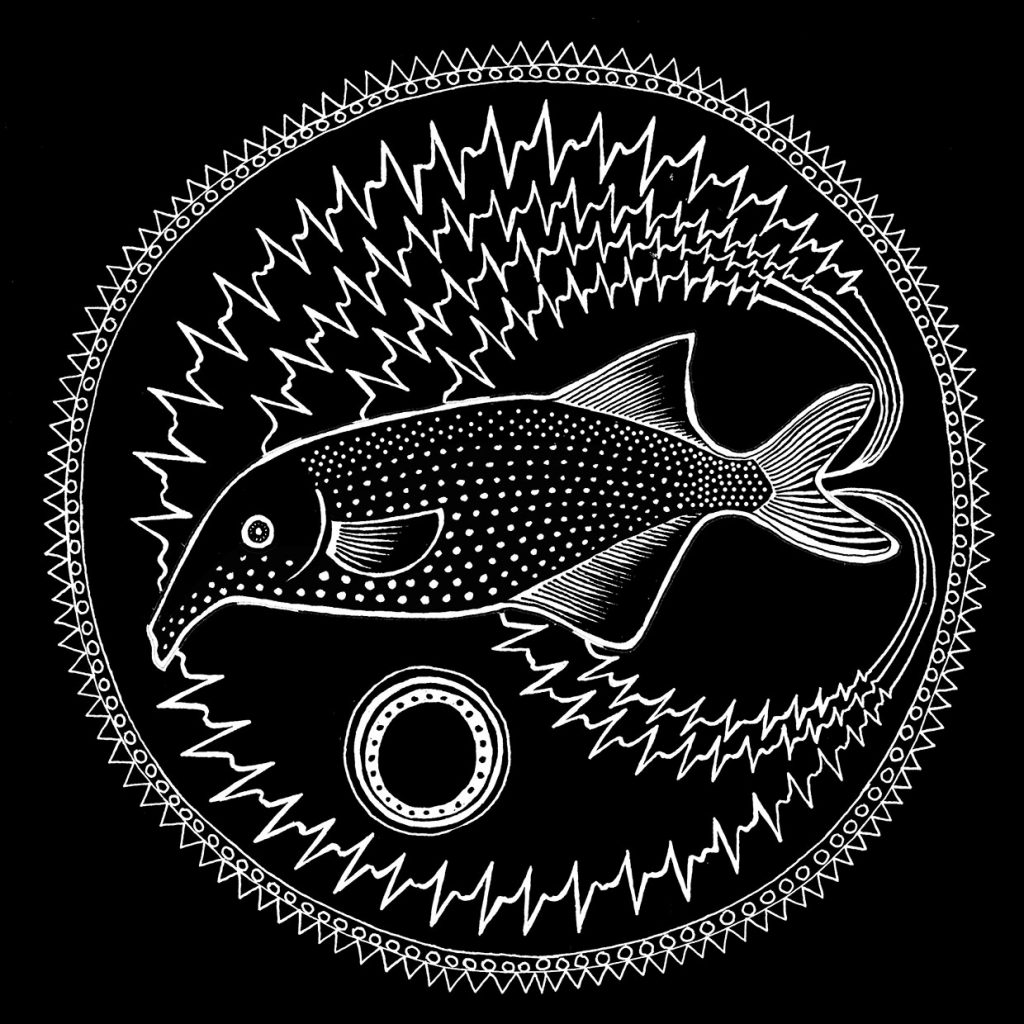
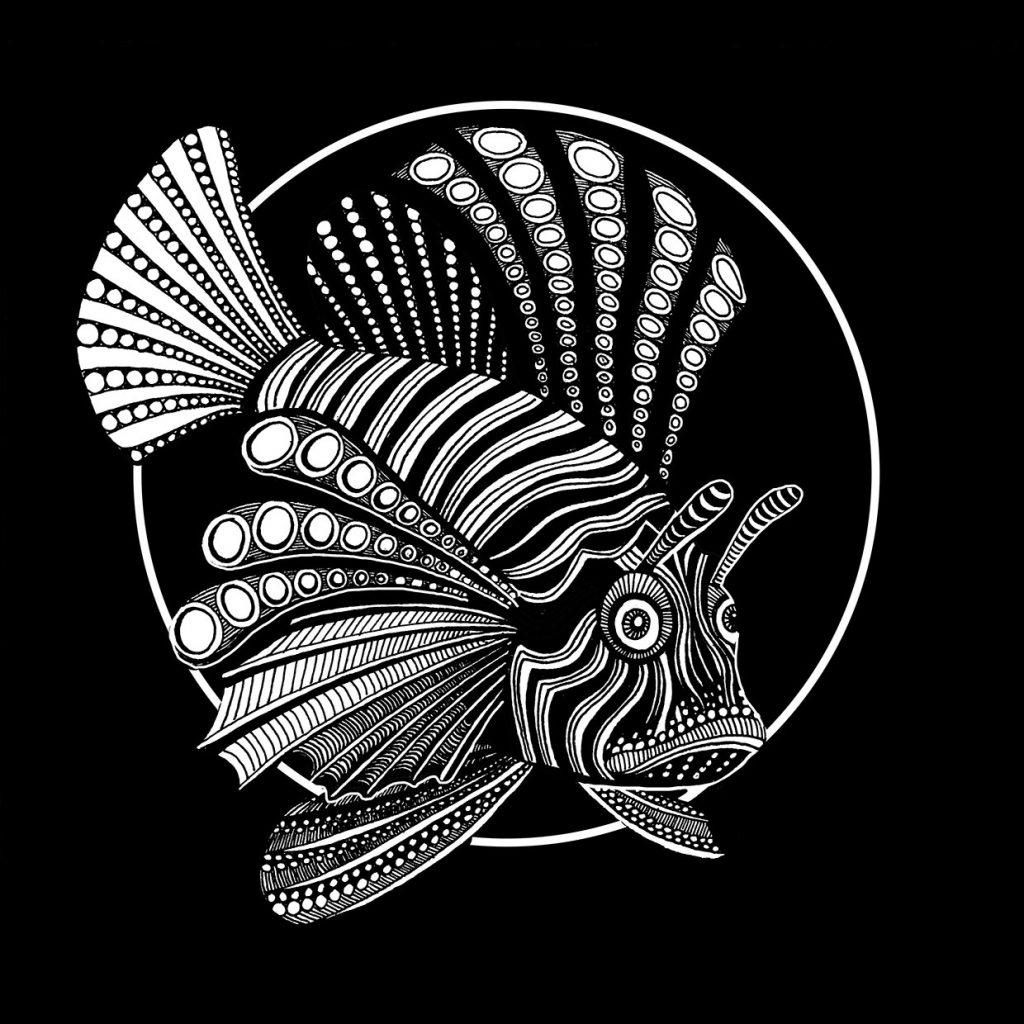
Lionfish: Pterois volitans
For about 20 years this magnificent fish has enjoyed a reign of terror in the Atlantic, from the gulf of Mexico to the eastern seaboard. They are dazzling predators, using unusual tactics of fin-flaring, and water streams jetting from the mouth, they engulf their prey whole and can extend their stomachs up to 30 times of their original volume to accommodate almost anything that comes their way. The problem however, is that they don’t belong in the Atlantic, but to their homeland in the indo-pacific. Here there are natural measures that keep the population from growing, to the fish here, the extravagant ambush tactics are an old hat, and there are enough natural predators. In their new habitat it doesn’t appear like anyone has quite figured out how to eat around the long poisonous spines, and their left undisturbed in their never-ending feast, destroying the biodiversity and leaving reefs in decimated states.
The Stargazer: Genus: Astroscopus
The poetic name is slightly over-romantic given the unpleasant look of this particular fish. He has a big upwards facing mouth and small staring eyes and is generally quite a sight to behold. Living halfly buried in sand and glaring at the upper world wearing a set of venomous, electrical shock emitting spinelets on the back. They can emit charges of up to 50 volts, enough to stun a fish or hurt a human.
They have a very unappealing appendage on their lower lip with which they lure prey, pretending to be an innocent piece of grass and then clasping their giant mouth around it.
Apparently they are considered a delicacy.

Red bellied Piranha: Pygocentrus nattereri
Despite the bloodthirsty and aggressive image that piranhas get in the media, most species are actually quite harmless. However, there have been reports of some species, such as the red-bellied Piranha, engaging in the occasional toe or leg nibble when an unassuming fishermen comes to close. Piranhas are found in the rivers of South America where they roam from upstream habitats to the coastal river mouths.
They are nesting animals, who go through courtship rituals, and after the eggs have been fertilised the happy couple will stick around and take turns in guarding the little ones. While they so Form shoals (large unorganized groups of fish) this is counter to popular belief not an effort to inspire terror in anyone who might happen upon them, but rather a defense against predators in the water and air.
While many fish make sounds, this has been much studied in red-bellied Piranhas and scientists have discerned three different sounds made for different occasions, so there is clearly some kind of piranha-speak.
Deep Sea Anglerfish Caulophryne jordani
Creepy looking, with a bright bacteria-fuelled “Esca” on the front of their head, anglerfish roam in the dark waters where the night never ends and food is scarce.
Anglerfish confused scientists for a long time, as all specimen that were found in trawls and other samples were identified as female. The complete absence of anglerfish with male gonads presented a mystery that was only solved when researchers had a closer look at the bodies of the retrieved females. With few exceptions these females had firmly lodged wormlike parasites on their body. Upon inspection it was found that these parasites were in fact filled with sperm- the missing males were found!
One of the things that makes anglerfish extraordinary
within their own family, as well as among all vertebrates
is their sexual dimorphism and mode of reproduction. This means that males in some species are up to half a million times lighter than their prospective wives. Wive is a key word, as once attached by their strong jaws the males are committed to that one lady till death parts them. In many species the site of attachment becomes a unification in a literal sense, as their bloodstreams merge and the male’s nutritional needs are now intravenously and exclusively met by his partner. It is thought that this extreme form of codependence is necessary in the environment that deep-sea anglerfish inhabit. When the chances of meeting a mate in the eternal darkness are so slim, you better hang on for dear life once you have found someone.
